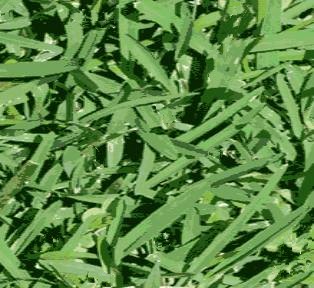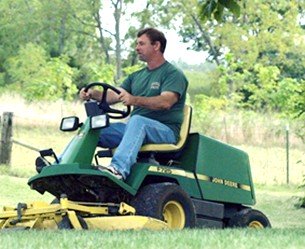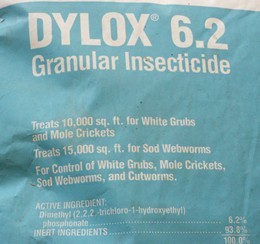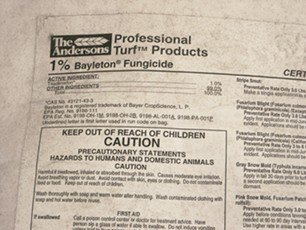St Augustine Grass
A Deep South Favorite
In the deep south, from Florida to central Texas, St Augustine grass is the turf of choice. It is a tropical grass being found in several countries and islands from Africa to Australia.
The southern states in the warm/humid Climate Zone in the U.S. forms the range for this grass. A line from South Carolina to north central Texas marks the northern boundary for this grass. St Augustine grass is not very drought or cold tolerant, so its western range drops off west of Ft. Worth, Texas.
The primary species used in the U.S. is "Stenotaphrum secundatum". This species is called by its common name of St Augustine. In other countries, it goes by other names. For any Australian readers, the land Down Under calls this grass buffalograss. However, in the U.S., buffalograss is a completely different warm season grass.
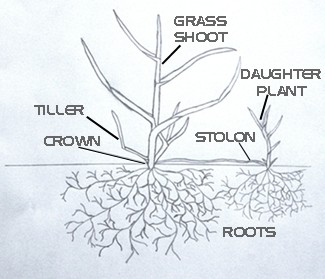
St Augustine grass is a coarse textured grass that spreads by stolons. It does not produce any rhizomes. The stolons can grow to be several feet long and root at the nodes. Click here for detailed information on grass stolons and plant structure. Because of the coarse texture, it is rarely used on golf course fairways. It is not a good grass for sports fields because of its low wear tolerance, so its primary use is for home or business lawns.
St Augustine grass can only be started vegetatively, with sod being the primary method. Seeded varieties have been developed, but poor performance led to their demise. It would be great if one day a good St Augustine grass seed was developed.
There are a number of different St Augustine varieties that are available for the public. Breeding is being done to improve the grass and to make a more SAD and chinch bug resistant turf. The chinch bug is very small insect, but a major pest. SAD (St Augustine Decline) is a disease that is caused by a virus. Since there is no cure for a virus, the only hope is to plant a variety that is more resistant to it. The perfect disease and insect free St Augustine grass is still a long way off, but scientist are trying.
Advantages of St Augustine grass
St Augustine grass makes a beautiful light green to dark green turf. It forms a dense turf that grows well in most soils throughout the south. It is used along the coastal ranges because of its good salt tolerance.
St Augustine also has good shade tolerance even under the beautiful live oak trees the south is so famous for. Great shade tolerance is one of the reasons it is preferred over bermudagrass. Bermudagrass has very poor shade tolerance and will only grow a couple feet into moderate to heavy shade.
The easiest way for establishment is by sod. It will give you an instant yard. The roots won’t take hold in the soil for a couple of weeks, so it will need to be watered carefully to keep from drying out. It can also be established from plugs and sprigs. Sprigs are stolons, often called, “runners”. Stolons are above ground stems that grow horizontally. The stolons will sprout and root at the nodes that form every few inches along it’s length. The daughter plants will be a clone of the mother plant. Once the stolon has securely rooted, you can cut the stolon and force the daughter plant to take on the role of a mother plant sending out more stolons. This will decrease the spread time.
St Augustine grass will go dormant when the soil temperatures fall below 55 degrees. If the soil remains warmer than 60 degrees all year, the grass will stay green. It will, however, slow in growth as the soil drops in temperature.
Disadvantages of St Augustine grass
One of the disadvantages of St Augustine grass is its poor wear tolerance. It will hold up well under to normal traffic of a home lawn, but not under the heavy traffic of an athletic field. The coarse texture makes it unsuitable for golf courses and is only used in a few places. Even many homeowners don’t care for the coarse texture and would prefer a finer bladed grass instead.
St Augustine also has poor drought tolerance and will not always hold its color without irrigation. This is one of the reasons why its range ends west of Ft. Worth, TX where the climate becomes drier. The northern range of St Augustine grass ends north of Dallas, TX and in South Carolina on the east coast. It is very susceptible to winter damage much farther north. Even within the northern sections of its range, bad winters could cause damage. Micro-climates can affect growth habits in the northern parts.
SAD (St Augustine Decline) and chinch bugs can be a severe pest.
Maintenance and Lawn Care Tips
Maintenance Tips for St Augustine Grass
Common Problems
St Augustine Grass is one of the most popular grasses on the southern coastal regions from Florida and Georgia to Texas and is growing in popularity in Southern California. But it is not without problems.
I often get questions about St Augustine Grass runners growing on the grass surface or sticking up in the air. The runners may be several feet long and not pinned to the soil. This is called "Looping".
There is no single reason or solution. Here are a few possible reasons for looping. Although I do travel to Southeast Texas to examine St Augustine, I have not studied in depth or verified these causes or solutions because of limited access. These are possible causes that were submitted to me by turf managers.
- Mowing too low for your variety
- Pre-emergent applied too heavily in the spring
- May be a temporary problem in late spring or mid to late summer that corrects itself
- Soil Nitrogen or nutrient deficiency
If the problem doesn't go away you may need to verticut the lawn. Care must be taken because St Augustine spreads by above ground stems and the dethatching may remove too many healthy stems, especially if they are not rooted.
Irrigation
The least expensive method of irrigation is to water whenever the grass needs it. Water deeply to wet the soil to a depth of 3 or 4 inches. This promotes deeper root growth and helps the grass survive longer without water during periods of drought. The grass will tell you when it is time to water again. When the grass begins to turn a bluish green color, it is time to water deeply again. Another way to tell is by walking across the lawn and then checking to see if your footprints are not immediately going away. If the grass does not spring back up, then it is time to water. Avoid watering at night, but instead, water in the morning hours so the soil surface has time to dry before evening. Damp grass and soil is a condition necessary for certain diseases to take off.
Mowing
Most varieties do well at 3 to 4 inches. If you haven't planted yet and know you would prefer a lower cut, you can always try a dwarf species. The variety Amerishade is an example of a dwarf variety and can handle 1.5 to 2 inches mowing height. A very level surface is required to keep from scalping the grass. Note however, that some dwarf varieties are more prone to thatch, winter damage and insect problems.
It is always best to check with your local extension office to see which varieties are best in your location.
Sharp blades are essential for a clean cut. Dull blades will shred the grass and may give a light brown appearance to the grass.
Sodding
Sodding is the most expensive, but the fastest way to get an instant yard. Many companies specialize in this work or you can do it yourself. Proper soil and grading preparation is necessary to ensure a good surface. Without a smooth surface, the mower will cut highs and lows. I have seen a lot of scalped yards because of poor preparation.
Since the roots are not anchored into the soil for few weeks, it is necessary to water everyday to keep the grass from drying out. Don’t water heavily, you don’t want to water log the soil. Don’t mow until the grass has sufficient root and is anchored to the soil or it may lift and be cut by the mower blades.
Plugging and sprigging are other ways of planting St Augustine grass. Plugging is planting grass squares while sprigging is planting the grass stolons. The plugs should be place from 6 to 12 inches apart. St Augustine grass can be plugged at 24 inches apart, but will take longer to fill in. If using stolons, the stolons must be covered over with a thin layer of dirt except for the grass blades. This encourages rooting. It is extra work, but will give better results. Some people just scatter the stolons, but that is leaving a lot to chance that they will root and grow.
Seeding
There was a time when St Augustine grass seed was being made available in limited quanities. However, the seed performed poorly and is no longer available. As it stands now, no seed is available for St Augustine grass. Maybe some day it will.
Fertilization
St Augustine grass requires approximately 4 to 5 lbs nitrogen per 1000 sq. ft. per year. If the grass is being started with plug or with stolons, apply 1 lb nitrogen per 1000 sq. ft. each month during the growing season. This will promote the fastest growth and spread. Established grass only needs 4 to 5 lbs per year. Over-fertilization of mature turf only encourages thatch, insect and disease problems.
Fertilization can be confusing for many people. To maintain a proper fertility program, it is important to know how much nitrogen is being delivered. We have made it easy to understand. Click on the link to learn more about lawn fertilization.
Thatch
St Augustine grass is one of several grasses that can create thatch. Over-fertilization is one of the biggest culprits in thatch build up. Soil pH problems can be another. Thatch is acidic, so if needed, an application of agricultural limestone will help prevent the development of thatch and reduce soil acidity. A soil test will tell you what your soil pH is. A third reason for thatch development is excessive watering. Daily water, regardless of whether it needs it or not can contribute to thatch.
Thatch is not soil, but an organic layer that develops between the soil and grass vegetation. It primarily consists of shed roots, stems and other grass debris. Grass completely sheds its root system twice a year, one root at a time. It grows new roots to replace the old ones. Thatch can be a barrier that prevents water and nutrients from reaching the roots. The roots can't tell the difference between soil and thatch, so the new roots will frequently grow through the thatch. The grass suffers because thatch dries out much faster than soil and the new roots quickly die. If the thatch completely dries out, it can crust over becoming "hydrophobic". Water will not penetrate through hydrophobic thatch, but instead, will pool on the surface. Fertilizers, pesticides, and herbicides have difficulty penetrating the thatch and become trapped in it. Tests have shown that almost 100% of insecticides become trapped in heavy thatch. This could also prevent insecticides from controlling the target insects.
Core aeration opens up the soil allowing water and air to reach the root zone. You should leave the cores on the grass to break down naturally. As the cores break down, they feed the soil micro-organisms.
Top dressing is the process of scattering a thin layer of organic matter over the surface of the grass. A thin layer of quality organic matter will feed the beneficial micro-organisms that, in turn, feed on the thatch. If needed, vertical mowing or dethatching machines, can be rented to tear out the thatch.
St Augustine Grass Insect and Disease Problems
Insects That Damage St. Augustine Grass
The major pest of St Augustine grass is the chinch bug. This is a tiny insect that pierces through the grass with needle-like mouth parts and sucks out the juices. Chinch bug saliva is toxic to the grass and will only accelerate the damage. Damage will usually show up as the weather warms up in spring. It will look similar to drought stress in the beginning stages.
A standard method is checking for chinch bugs is by cutting out the ends of a large coffee can. Press the can into the ground on the edge of the damaged area. Fill the can with water and watch for the chinch bugs to float to the top. They will be the size of an ant. The can will lose water quickly as it absorbs into the ground, so make sure the water is always above the grass line inside the can. It make take a few minutes to see the bugs float up. Insecticides are available for controlling this pest, but some have developed resistance to certain insecticides.
Other insects pests include sod webworms, cutworms, grub worms and mole crickets. Grass hoppers can also be a problem in summer months.
A good biological control for white grubs, sod webworms and cut worms is the microbial insecticide called “Baccilus Thuringensis”. Once consumed by the insects, it kills by producing toxins within their gut. Mach 2 is another biological control for insects that pupate. The active ingredient is "Halofenozide" and kills the target insects by interrupting the pupation stage of larvae without harming beneficial insects. This product needs to be applied well in advance of any damage. It will have no effect of applied at the time insects are damaging your lawn.
Quick kill products include trichlorofon (dylox) and carbaryl (sevin). Be aware that thatch can hinder the movement of insecticides to the root zone where grubs live. Always follow the label directions and wear all required personal protection equipment and clothing.
Some pest controls, including some biological controls, are available only to certified pesticide applicators. Many commercial applicators will apply what you need without selling you a whole program. Check with companies in your area to see.
Diseases Common to St. Augustine Grass
Brown patch, take all root rot, and grey leaf spot are all problems of St Augustine grass in wet, humid, summer weather. The Bayleton fungicide, as well as others, are labeled for many diseases that effect St Augustine.
Take all root rot is a problem of wet soil, most prevalent during the planting stage, but can also occur in established grass. With this disease, as the name sounds, the roots rot and the plant dies. Good, well drained soil is necessary for planting and growing. Make sure you don’t over water during the planting stage so the soil becomes waterlogged.
Grey leaf spot is mostly a problem with young plants in humid, wet conditions. Fungicides are available for all these diseases.
Brown patch is a disease in hot, humid weather. It begins as a 1 foot patch and can enlarge to several feet in diameter. The lesions that appear on the grass became tan in appearance as the grass tissue dries out. A sign of brown patch is the webby mycelium that appears on the grass on damp mornings. Avoid applications of nitrogen fertilizer and well as weed control when this disease is present. Nitrogen will only feed the fungus. As humidity decreases and weather dries out, the disease subsides and the grass usually recovers. As long as the grass crown is not affected, the grass will grow out of it. If you live in a section of the country where high humidity is the rule and not the exception, fungicides like Daconil are available to help control brown patch. Fungicides must be applied in the early stages of disease development for best results.
Important Note About Insecticides and Fungicides
Always read the label carefully before using any product and preferably before purchasing. If you know of a product you are considering, you can find the product label online. It will give you all the information you need to know before use, what personal protection clothing you need and if it is safe around pets or children or how long they need to stay off the lawn. Just type into the browser the product and include the word "label".
Common and Improved Bermudagrass
Bermudagrass is the most popular warm season grass in America. Read about the pros and cons of planting this grass, along with all you need to know to take care of your lawn.
The Beautiful Zoysia Grass
Zoysia grass was imported from the Orient and has become one of the leading warm season grasses in the U.S. Click here to learn about this beautiful grass and tips on how to care for it.
Centipede Grass - The Lazy Man's Grass
Centipede grass is a low maintenance, low fertility and slow growing turf grass that is adapted to the southern coastal regions of the U.S. Click here for detailed information on how to plant and care for this grass.
Buffalo Grass - A Truly American Turfgrass
Buffalo Grass, native to the U.S. Western Plains, once fed millions of American bison (buffalo) has now become a beautiful lawn and sports grass. Click here for buffalo grass facts, care and maintenance tips, adaptation range, popular varieties, and much more.
Watering a New Lawn
Watering a new lawn is very different from watering a mature lawn. When planting a new lawn, success will be greatly increased by learning proper watering techniques.
Overseeding Lawns - Detailed Tips and Techniques
Complete instructions and techniques for overseeding lawns. Bermudagrass is the most frequently overseeded warm season grass. Find out how to do this as well along with the types of seed you can use.
Lawn Winterization Tips and Techniques
Fall winterization is the most important time for fertilizing cool season grasses. Warm season grasses do not receive the same treatment. Find everything you need to know to winterize both cool and warm season grasses.
Organic Top Dressing
Compost top dressing is a fairly new practice for home lawns. Get helpful advice and step by step directions for the best possible results.
Organic Lawn Fertiliztion
The popularity of organic lawn care is increasing. click here for complete and unbiased information on how organics work, types of organics for home use and the different approaches to organic lawn care.
Lawn Fertilization Made Easy
Lawn fertilization is one of the most important aspects of lawn care. However, it is also one of the most misunderstood. This page is your gateway to understanding lawn fertilizer and soil fertility.
Lawn Moss and How to Control It
Lawn moss is a common problem in yards. However, its presence represents deeper soil problems that must be fixed or the moss will stick around. Find out what must be done to finally end your moss problems.
Dog Urine Damage on Lawns
We all love our pets, but dog urine can do a number on grass. There is hope. Find out what can be done to save your lawn and your pet too.
St Augustine Grass back to Lawn Care Academy Home
